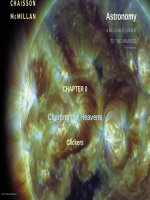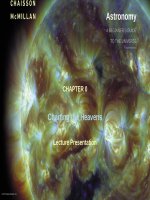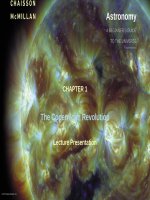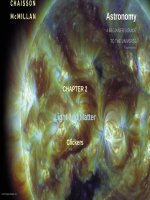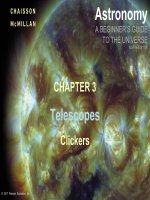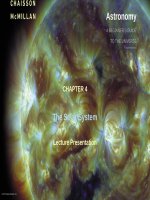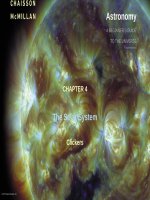Astronomy a beginners guide to the universe 8th CHaisson mcmillan chapter 12 clicker questions
Bạn đang xem bản rút gọn của tài liệu. Xem và tải ngay bản đầy đủ của tài liệu tại đây (1.56 MB, 35 trang )
Astronomy
A BEGINNER’S GUIDE
TO THE UNIVERSE
EIGHTH EDITION
CHAPTER 12
Stellar Evolution
Clickers
© 2017 Pearson Education, Inc.
Question 1
Stars like our Sun will end their lives as
a)
b)
c)
d)
e)
© 2017 Pearson Education, Inc.
red giants.
pulsars.
black holes.
white dwarfs.
red dwarfs.
Question 1
Stars like our Sun will end their lives as
a)
b)
c)
d)
e)
red giants.
pulsars.
black holes.
white dwarfs.
red dwarfs.
Explanation: Low-mass stars
eventually swell into red giants,
and their cores later contract
into white dwarfs.
© 2017 Pearson Education, Inc.
Question 2
Elements heavier than hydrogen and helium were created
a)
b)
c)
d)
e)
© 2017 Pearson Education, Inc.
in the Big Bang.
by nucleosynthesis in massive stars.
in the cores of stars like the Sun.
within planetary nebula.
They have always existed.
Question 2
Elements heavier than hydrogen and helium were created
a)
b)
c)
d)
e)
in the Big Bang.
by nucleosynthesis in massive stars.
in the cores of stars like the Sun.
within planetary nebula.
They have always existed.
Explanation: Massive stars
create enormous core
temperatures as red
supergiants, fusing helium
into carbon, oxygen, and even
heavier elements.
© 2017 Pearson Education, Inc.
Question 3
The Sun will evolve away from the main sequence when
a)
b)
c)
d)
its core begins fusing iron.
its supply of hydrogen is used up.
the carbon core detonates, and it explodes as a Type I supernova.
helium builds up in the core, while the hydrogen-burning
shell expands.
e)
© 2017 Pearson Education, Inc.
the core loses all of its neutrinos, so all fusion ceases.
Question 3
The Sun will evolve away from the main sequence when
a)
b)
c)
its core begins fusing iron.
its supply of hydrogen is used up.
the carbon core detonates, and
it explodes as a Type I supernova.
d)
helium builds up in the core,
while the hydrogen-burning
shell expands.
e)
the core loses all of its neutrinos, so all fusion ceases.
Explanation: When the Sun’s core becomes unstable and contracts, additional H fusion generates extra pressure,
and the star will swell into a red giant.
© 2017 Pearson Education, Inc.
Question 4
The helium flash occurs
a)
b)
c)
d)
e)
© 2017 Pearson Education, Inc.
when T-Tauri bipolar jets shoot out.
in the middle of the main-sequence stage.
in the red giant stage.
during the formation of a neutron star.
in the planetary nebula stage.
Question 4
The helium flash occurs
a)
b)
c)
d)
e)
when T-Tauri bipolar jets shoot out.
in the middle of the main-sequence stage.
in the red giant stage.
during the formation of a neutron star.
in the planetary nebula stage.
Explanation: When the collapsing
core of a red giant reaches high
enough temperatures and
densities, helium can fuse into
carbon quickly—a helium flash.
© 2017 Pearson Education, Inc.
Question 5
Stars gradually lose mass as they become white dwarfs during the
a)
b)
c)
d)
e)
© 2017 Pearson Education, Inc.
T-Tauri stage.
emission nebula stage.
supernova stage.
nova stage.
planetary nebula stage.
Question 5
Stars gradually lose mass as they become white dwarfs during the
a)
b)
c)
d)
e)
T-Tauri stage.
emission nebula stage.
supernova stage.
nova stage.
planetary nebula stage.
Explanation: Low-mass stars forming
white dwarfs slowly lose their outer
atmospheres and illuminate these
gases for a relatively short time.
© 2017 Pearson Education, Inc.
Question 6
Astronomers determine the age of star clusters by observing
a)
b)
c)
the number of main-sequence stars.
the ratio of giants to supergiants.
the luminosity of stars at
the turnoff point.
d)
e)
© 2017 Pearson Education, Inc.
the number of white dwarfs.
supernova explosions.
Question 6
Astronomers determine the age of star clusters by observing
a)
b)
c)
the number of main-sequence stars.
the ratio of giants to supergiants.
the luminosity of stars at
the turnoff point.
d)
e)
the number of white dwarfs.
supernova explosions.
Explanation: The H–R diagram
of a cluster can indicate its
approximate age.
Turnoff point from
the main sequence
© 2017 Pearson Education, Inc.
Question 7
The source of pressure that makes a white dwarf stable is
a)
b)
c)
d)
e)
© 2017 Pearson Education, Inc.
electron degeneracy.
neutron degeneracy.
thermal pressure from intense core temperatures.
gravitational pressure.
helium–carbon fusion.
Question 7
The source of pressure that makes a white dwarf stable is
a)
b)
c)
d)
e)
electron degeneracy.
neutron degeneracy.
thermal pressure from intense core temperatures.
gravitational pressure.
helium–carbon fusion.
Explanation: Electrons in the core
cannot be squeezed infinitely close
and prevent a low-mass star from
collapsing further.
© 2017 Pearson Education, Inc.
Question 8
In a white dwarf, the mass of the Sun is packed into the volume of
a)
b)
c)
d)
e)
© 2017 Pearson Education, Inc.
an asteroid.
a planet the size of Earth.
a planet the size of Jupiter.
an object the size of the Moon.
an object the size of a sugar cube.
Question 8
In a white dwarf, the mass of the Sun is packed into the volume of
a)
b)
c)
d)
e)
an asteroid.
a planet the size of Earth.
a planet the size of Jupiter.
an object the size of the Moon.
an object the size of a
sugar cube.
Explanation: The density of a white dwarf is about a million times greater than normal solid matter.
© 2017 Pearson Education, Inc.
Question 9
In a young star cluster, when more massive stars are evolving into red giants, the least massive stars
are
a)
b)
c)
d)
e)
© 2017 Pearson Education, Inc.
ending their main-sequence stage.
also evolving into red giants.
forming planetary nebulae.
barely starting to fuse hydrogen.
starting the nova stage.
Question 9
In a young star cluster, when more massive stars are evolving into red giants, the least massive stars
are
a)
b)
c)
d)
ending their main-sequence stage.
also evolving into red giants.
forming planetary nebulae.
barely starting to fuse
hydrogen.
e)
starting the nova stage.
Explanation: More massive stars
form much faster and have much
shorter main-sequence lifetimes.
Low-mass stars form more slowly.
© 2017 Pearson Education, Inc.
Question 10
A star will spend most of its “shining” lifetime
a)
b)
c)
d)
e)
© 2017 Pearson Education, Inc.
as a protostar.
as a red giant.
as a main-sequence star.
as a white dwarf.
evolving from type O to type M.
Question 10
A star will spend most of its “shining” lifetime
a)
b)
c)
d)
e)
as a protostar.
as a red giant.
as a main-sequence star.
as a white dwarf.
evolving from type O to type M.
Explanation: In the mainsequence stage, hydrogen
fuses to helium. Pressure from
light and heat pushing out
balances gravitational pressure
pushing inward.
© 2017 Pearson Education, Inc.
Question 11
A nova involves
a)
mass transfer onto a white dwarf in a binary star
system.
b)
c)
d)
e)
© 2017 Pearson Education, Inc.
repeated helium fusion flashes in red giants.
rapid collapse of a protostar into a massive O star.
the explosion of a low-mass star.
the birth of a massive star in a new cluster.
Question 11
A nova involves
a)
mass transfer onto a white dwarf in a binary star
system.
b)
c)
d)
e)
repeated helium fusion flashes in red giants.
rapid collapse of a protostar into a massive O star.
the explosion of a low-mass star.
the birth of a massive star in a new cluster.
Explanation: Sudden, rapid fusion
of new fuel dumped onto a white
dwarf causes the star to flare up
and for a short time become much
brighter.
© 2017 Pearson Education, Inc.
Question 12
What type of atomic nuclei heavier than helium are most common, and why?
a)
b)
c)
d)
© 2017 Pearson Education, Inc.
Those heavier than iron, because of supernovae
Iron, formed just before massive stars explode
Odd-numbered nuclei, built with hydrogen fusion
Even-numbered nuclei, built with helium fusion
Question 12
What type of atomic nuclei heavier than helium are most common, and why?
a)
b)
c)
d)
Those heavier than iron, because of supernovae
Iron, formed just before massive stars explode
Odd-numbered nuclei, built with hydrogen fusion
Even-numbered nuclei, built
with helium fusion
Explanation: Helium nuclei have
an atomic mass of 4; they act as
building blocks in high-temperature
fusion within supergiants.
© 2017 Pearson Education, Inc.
